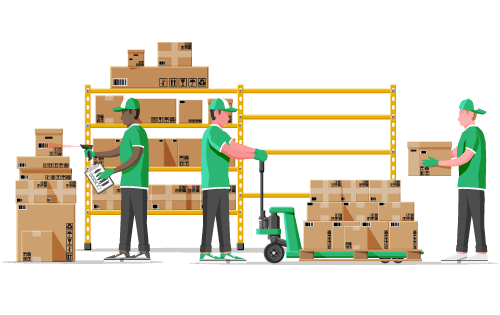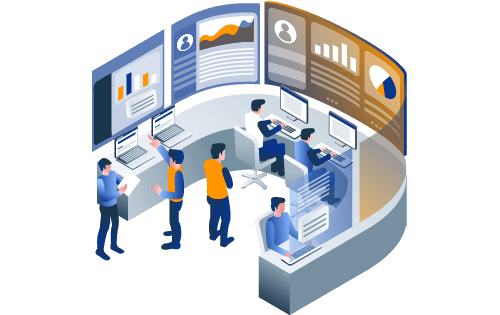Forecast Demand Accurately
Built For


Forecast Demand Accurately
Imagine running a business where you always have the right amount of stock, never face delays due to stockouts, and can easily meet customer demands. Sounds ideal, right? Thanks to demand forecasting, this perfect scenario can be closer to reality than you think.
Accurate demand forecasting is critical for any business. It helps you predict future sales, plan inventory, and meet your customers’ needs without overstocking or understocking.
In this article in our blog series discussing the benefits of inventory software, we’ll explore demand forecasting, why it’s crucial for your business, and how using inventory software can make this process easier and more precise. Understanding and implementing effective demand forecasting can save you time, money, and headaches, so let’s get started!
What is Demand Forecasting?
Demand forecasting predicts future customer demand based on market trends, historical data, and other factors. It’s a critical component of supply chain management that helps businesses plan and make informed decisions about inventory, production, and distribution.
There are two primary types of demand forecasting analysis:
Qualitative Forecasting
Qualitative forecasting relies on expert opinions, market research, and subjective judgment. It’s particularly useful when little historical data is available or when market conditions are expected to change significantly.
Quantitative Forecasting
This method uses historical sales data and statistical models to predict future demand. It’s more data-driven and objective, making it suitable for stable markets with plenty of historical data.
Key factors influencing demand forecasting include:
- Historical Sales Data: Past sales performance is often a reliable indicator of future demand.
- Market Trends: Understanding market dynamics and consumer behavior helps predict shifts in demand.
- Seasonality: Many products experience seasonal demand fluctuations, which need to be accounted for.
- Economic Conditions: Economic indicators such as unemployment rates and consumer confidence can impact demand.
- Promotions and Marketing: Advertising campaigns, discounts, and promotions can significantly influence demand patterns.
By leveraging demand forecasting, businesses can optimize inventory levels, reduce holding costs, improve customer satisfaction, and enhance operational efficiency. Accurate forecasting ensures that you have the right products in the right quantities at the right time, which is critical for maintaining a competitive edge in today’s fast-paced market.
Why Accurate Demand Forecasting is Crucial

Accurate demand forecasting is vital for the smooth operation and success of any business. Here’s why getting your demand forecasts right is so important:
Reducing Stockouts and Overstock Situations
Accurate demand forecasting allows you to maintain optimal inventory levels. This means you can avoid overstocking pitfalls, which tie up capital and increase storage costs, or, alternatively, understocking, which can result in missed sales opportunities and dissatisfied customers. With precise forecasts, you have just enough stock to meet demand without excess.
Improving Customer Satisfaction
Meeting customer demand consistently is vital to maintaining and enhancing customer satisfaction. When you can predict demand accurately, you ensure that products are available when your customers need them. This reliability builds customer trust and loyalty, leading to repeat business and positive word-of-mouth.
Optimizing Supply Chain Operations
A well-forecasted demand helps streamline supply chain operations. It enables better coordination with suppliers, reduces lead times, and ensures timely delivery of raw materials and products. This optimization reduces operational inefficiencies and helps maintain a lean and responsive supply chain.
Informed Strategic Planning
Demand forecasting isn’t just about day-to-day operations; it is crucial in long-term strategic planning. Accurate forecasts provide valuable insights into market trends and customer preferences, guiding business decisions such as product development, market expansion, and capacity planning. By understanding future demand, businesses can make informed investments and strategic moves.
Financial Planning and Budgeting
Reliable demand forecasts are essential for effective financial planning and budgeting. They help in predicting revenue, managing cash flow, and allocating resources efficiently. Accurate forecasting enables businesses to anticipate financial needs and avoid unnecessary expenditures, contributing to healthier financial stability.
Adapting to Market Changes
Markets are dynamic and constantly evolving. Accurate demand forecasting allows businesses to adapt quickly market conditions, consumer behavior, and economic factors. By keeping ahead of market trends and anticipating shifts in demand, companies can remain agile and competitive in their industry.
Using Inventory Software for Demand Forecasting

Leveraging inventory software for demand forecasting can significantly enhance the efficiency and accuracy of your forecasting process. Here’s how inventory software, especially when integrated with QuickBooks, can help:
Inventory Software
Inventory software helps businesses manage and control their stock levels, orders, sales, and deliveries. When it comes to demand forecasting, the software provides valuable tools and insights to predict future demand based on historical sales data and trends.
Data Collection and Integration
A crucial aspect of inventory software is its ability to consolidate data from various sources. Integrating your inventory software with QuickBooks allows you to streamline the data flow between your accounting and inventory management systems. This integration ensures that all your sales, purchase orders, and inventory adjustments are automatically updated in real time, providing a comprehensive data set for accurate demand forecasting.
- Historical Sales Data: Inventory software collects and analyzes sales data to identify patterns and trends.
- Inventory Levels: Real-time tracking of stock levels helps understand the turnover rates of different products.
- Market Trends: The software can enhance the accuracy of forecasts by incorporating data on sales trends and consumer behavior.
Data Analysis
Inventory software has built-in analytical tools that help in processing and analyzing data to generate accurate demand forecasts. These tools identify seasonal patterns, detect trends, and account for variables like promotions and market changes.
Implementation and Monitoring
Once the forecast is generated, the next step is to implement it into your inventory planning. Inventory software helps translate demand forecasts into actionable inventory management plans.
- Inventory Planning: Allocate resources and plan inventory purchases based on the forecasted demand.
- Real-Time Monitoring: Continuously monitor inventory levels and sales to adjust forecasts and plans as needed. The integration with QuickBooks ensures that all financial data is up-to-date, facilitating seamless planning and execution.
Benefits of Using Inventory Software
Using inventory software for demand forecasting offers numerous benefits:
- Increased Accuracy and Efficiency: Automating the data collection and analysis process reduces human errors and enhances the precision of forecasts.
- Enhanced Visibility and Insights: Gain comprehensive insights into inventory levels, sales patterns, and market trends.
- Scalability and Flexibility: The software can scale with your business and adapt to changing market conditions, ensuring your forecasting processes remain effective as your business grows.
Best Practices for Accurate Demand Forecasting

Implementing accurate demand forecasting requires a combination of good practices and the right tools. Here are some best practices to help ensure your demand forecasts are as precise and helpful as possible:
Keep Up-to-Date with Market Trends
Markets and consumer behaviors are constantly changing, so it’s crucial to stay abreast of market changes such as:
- Economic Conditions: Monitor economic indicators such as GDP growth, unemployment rates, and consumer confidence.
- Seasonality: Account for seasonal variations that affect demand for specific products.
- Market Trends: Stay informed about industry trends, competitive actions, and technological advancements.
- Regulatory Changes: Be aware of new laws or regulations that might affect product demand.
Collaborate Across Departments
Accurate demand forecasting is a collaborative effort that benefits from the input of various departments within your organization. Engage teams from sales, marketing, finance, and supply chain to gather insights and ensure that all relevant factors are considered. This cross-functional collaboration helps create a more comprehensive and accurate forecast.
Leverage Inventory Management Software
Utilize advanced inventory management software that integrates seamlessly with your accounting and sales systems. Software like Acctivate, when integrated with QuickBooks, can automate data collection, analysis, and forecasting. This integration ensures that your forecasts are based on real-time data and reduces the chances of human error.
Implement Continuous Monitoring and Adjustment
Demand forecasting is not a one-time activity but an ongoing process. Continuously monitor your forecasts and compare them with actual sales to identify discrepancies. Use this information to adjust your models and improve future forecasts. This iterative approach helps refine your forecasting accuracy over time.
Plan for Different Scenarios
Prepare for various scenarios by creating multiple demand forecasts based on different assumptions. This approach, known as scenario planning, helps you anticipate potential changes in demand and develop contingency plans. By considering best-case, worst-case, and most-likely scenarios, you can be better prepared for uncertainties.
Continuously Learn from Past Forecasts
Review your past forecasts regularly to understand what worked well and where inaccuracies occurred. Analyze the reasons behind any deviations from actual demand and use these insights to refine your forecasting process. Learning from past experiences helps improve the precision of future forecasts.
By following these best practices, you can enhance the accuracy of your demand forecasts, leading to improved inventory management, reduced costs, and higher levels of customer satisfaction. Accurate demand forecasting is key for successful business operations, and adopting these practices will help you stay ahead in a competitive market.
Case Study: Making a Difference for Cyclists

BikeFit, founded in 1995, specializes in producing bicycle fitting tools and products to alleviate the physical discomforts that active cyclists and triathletes often face. Their products, such as Cleat Wedges, Leg Length Shims, and Pedal Spacers, enhance comfort and improve bike rides.
“Initially, the company was created to help people eliminate discomfort on their bicycles. Cyclists were experiencing significant injuries and leaving cycling altogether. Our founder created products to help people customize their asymmetrical bodies to symmetrical bikes to alleviate pain and increase power and efficiency,” said Damon Wyatt, Operations Manager.

BikeFit also offers educational resources, including print materials, online courses, and hands-on seminars about best bike fitting practices, catering to private businesses and bike shops.
Despite their success, BikeFit faced challenges due to a lack of visibility and an absence of a centralized system for managing inventory and business operations. Damon Wyatt juggled multiple roles, from sales and marketing to administration and customer service.
“We’re small, I wear about 27 different hats. You can ask me any question about pretty much any portion of our company and I’ll have an answer,” Damon said.
BikeFit implemented Acctivate, a comprehensive inventory and business management solution, to address its inventory challenges. Since adopting Acctivate, BikeFit has significantly improved control, efficiency, and forecasting. The software enhanced its processes, transparency, and communication with the warehouse. Damon can now monitor warehouse activities, access timely shipping information, ensure accurate inventory tracking, and better plan for future demand.
“Our efficiency, process, transparency, and communication with our warehouse improved dramatically. I can observe the process of the pick and respond to customers in a timely fashion with needed packaging information. The process has been awesome,” Damon said.
Before Acctivate, BikeFit struggled with disjointed processes and needed more visibility. Now, they enjoy enhanced efficiency, accuracy, and insight into their daily operations, allowing for better task management and demand forecasting.
“From where we were before we started with Acctivate, we are 10,000 times more efficient. You can track me on that number, that’s real. We’re clearly much more efficient than we used to be,” Damon concluded.
Call us at 817-870-1311





